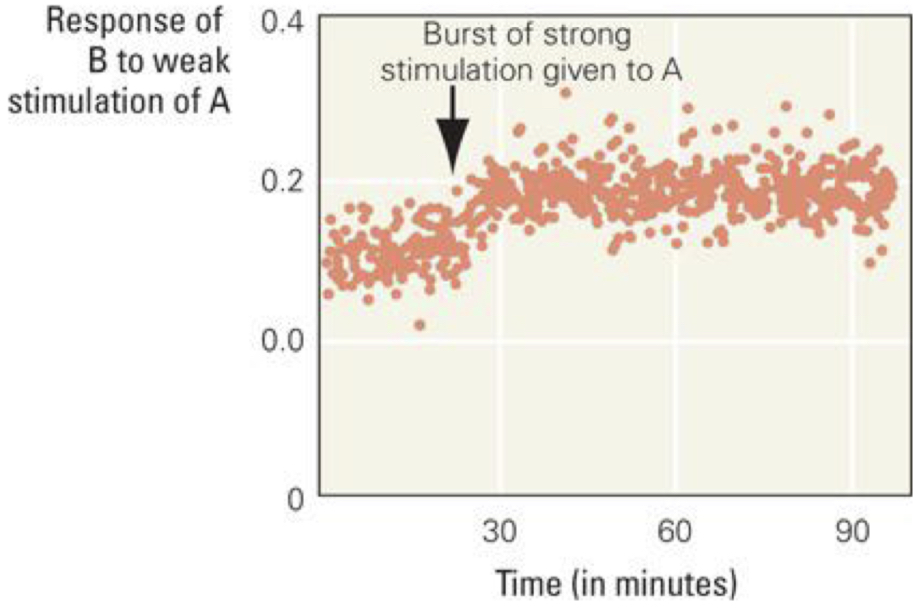PSY260 Lecture 7: Episodic & Semantic Memory
1/35
There's no tags or description
Looks like no tags are added yet.
Name | Mastery | Learn | Test | Matching | Spaced |
|---|
No study sessions yet.
36 Terms
Squire’s Model of Long-Term Memory (LTM)
Long-term memory → declarative + nondeclarative memory
Nondeclarative memory → procedural (motor) memory + implicit memory
Declarative memory → semantic memory + episodic memory
Endel Tulving
1927-2023
Cognitive psychologist at UofT
Distinguished between episodic and semantic memory
Episodic memory = “mental time travel“
Memories for specific events are tied to time and place where the info was learned (context)
Hippocampus → binding context + content
Essential for episodic memory
Semantic Memory
General world knowledge
Fairly stable knowledge, typically shared with the community (common knowledge)
Ex. world events
Episodic vs. Semantic Memory
Distinction between episodic and semantic memory first made by Tulving (1972)
More recent research has suggested the difference isn’t quite that simple
There is overlap
Both conscious, declarative forms of memory
We are aware and can vocalize
Sensorimotor Framework
A concept is encoded as a specific combination of sensory, motor, and other modality specific features
Different classes of representations can be modality dependent
Semantic memory provides a framework for interpreting and organizing new events or new information
Allows us to predict the future with higher accuracy
How Does Conceptual Knowledge Benefit Memory?: Baseball study
Asked baseball experts vs. non-experts to recall a fictional game
More conceptual knowledge resulted in:
Better memory for information overall
More organized recall; events recalled in proper sequence
More relevant information remembered
Better prediction of the outcome
The more you know, the more you CAN know
Easier to add new information
↑ plasticity in network
Semantic Network Organization
Semantic memory seems to be stored in laarge, distributed networks of associated concepts and ideas
Big networks and co-activation of different brain areas
Concepts are not understood in isolation
When one concept is activated, this activation spreads to related concepts
Semantic Networks
Semantic interconnectivity
More associations → faster retrieval
More associations = more potential retrieval pathways
Hub and Spokes Model
Hub = central concept
Spokes = related/associated concepts
Related concepts end up closer to each other
↑ connected concepts → ↑ retrieval speed
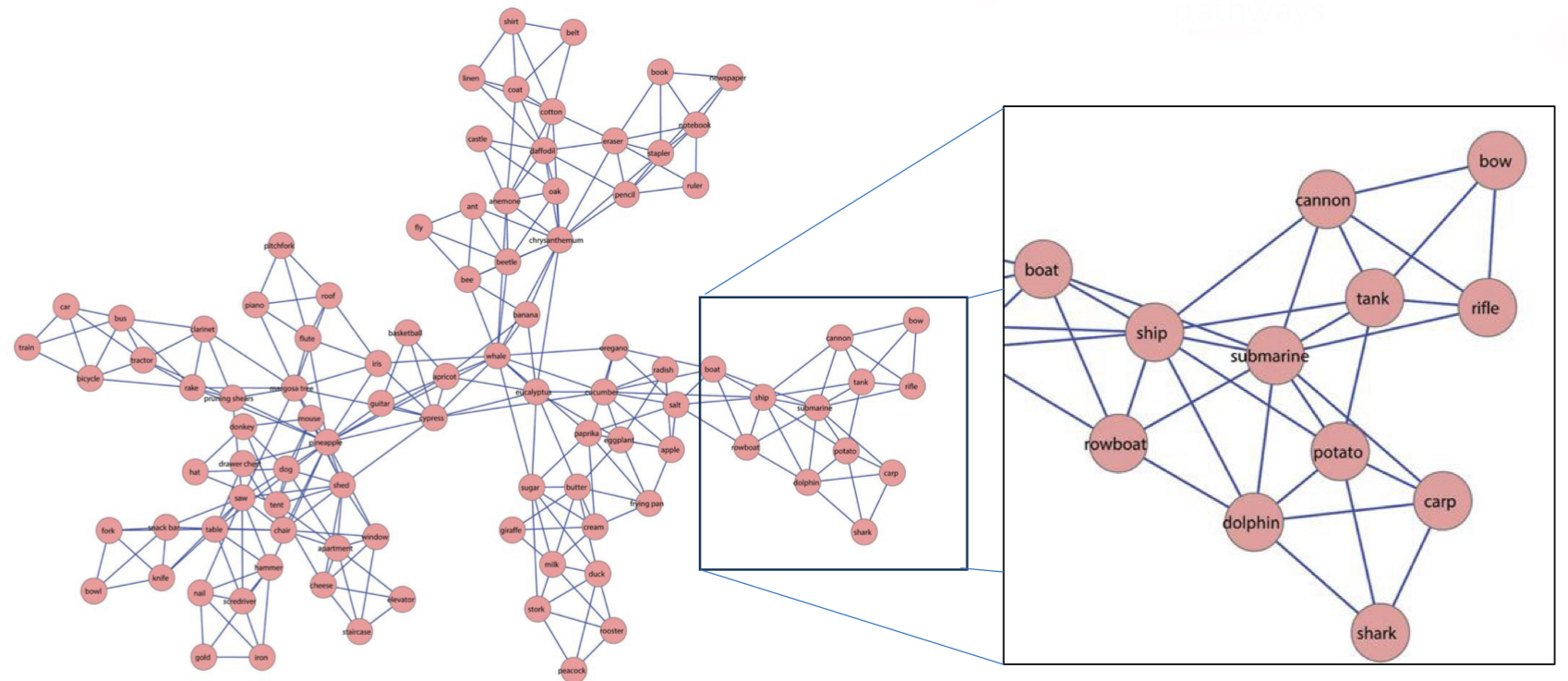
Episodic Memory
Collection of personal experiences that often includes contexts
Context: who, what, when, where, why, etc.
There contextual details can serve as cues
If a cue is activated → the entire memory trace can be reactivated
Ex. smell something → recall a whole memory
Ex. PTSD → cue something that triggers traumatic memory
Results from functional neuroimaging studies have shown support for this
Can see a cue activating a network
Semantic vs. Episodic Memory: Table
Episodic
Can be communicated flexibly
Consciously accessible
Tagged with spatial/temporal context
Must have experienced event personally
Learned in a single exposure
Semantic
Can be communicated flexibly
Consciously accessible
Not necessarily tagged with spatial/termporal context
Can be personal/general information
Can be learned in single exposure, strengthened by repetition
Strength with Repeated Exposure
Semantic → stronger with repetition
↑ details remembered
Episodic → weaker with repetition
↓ details remembered
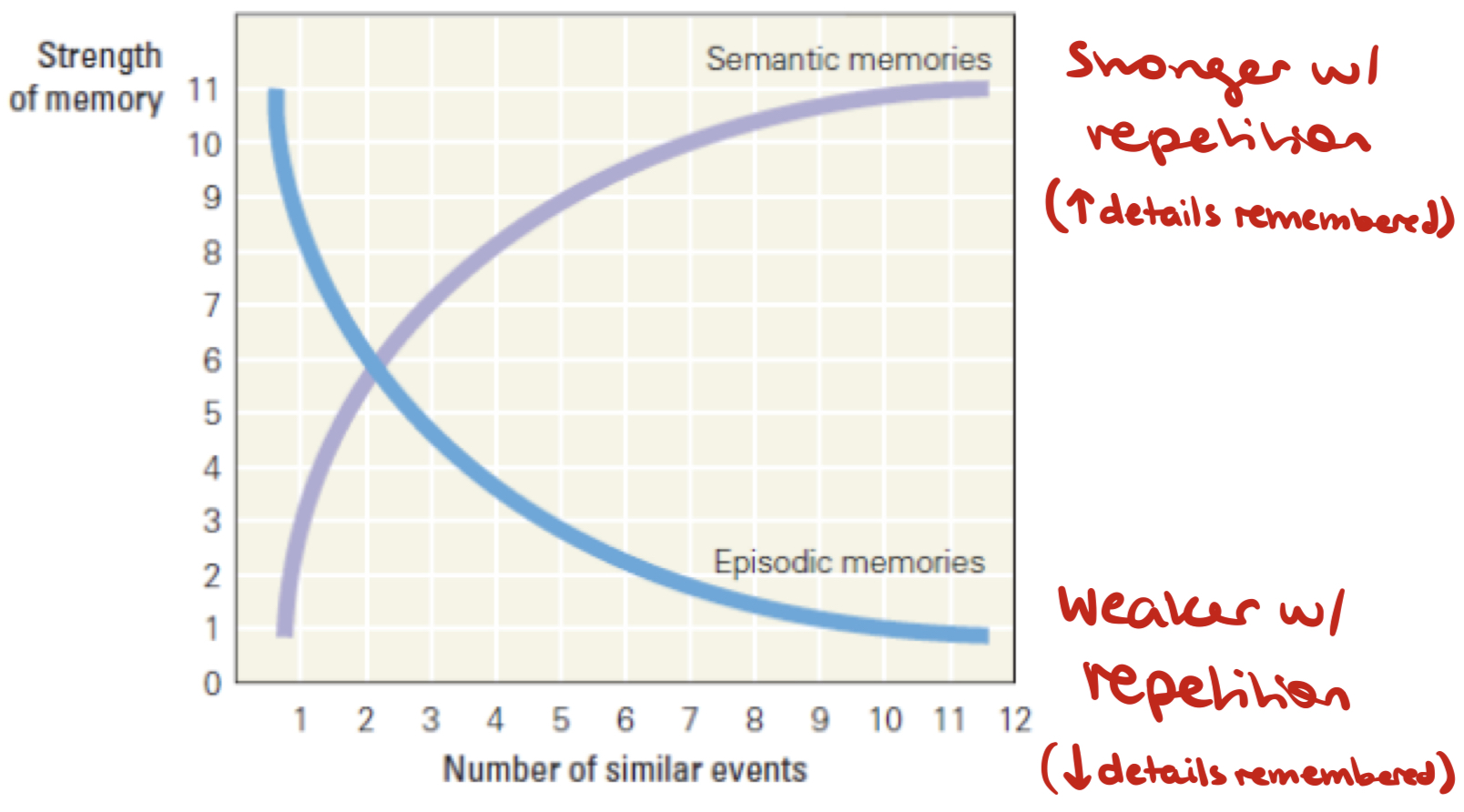
Which is First: Episodic/Semantic?
Episodic may develop only after sufficient semantic memories are formed
Ex. can’t remember a grad ceremony if you don’t know what graduation is
Semantic may develop from repeated episodic
Encounter same information in multiple contexts → more whole understanding
Specific episodes blend → form a strong semantic memory
Or, both systems depend one each other
All have potential for truth
Highly Superior Autobiographical Memory (HSAM)
Very detailed, episodic memories of everything
Hyperthymesia
Tend to have really vivid visual imagery
Hyperphantasia
Severely Deficient Autobiographical Memory (SDAM)
Tend to rely on semantic descriptions of things that have happened, without feeling like they’re actually reexperiencing anything
More like a semantic list framework
Tend to have very poor or no visual imagery
Aphantasia
Semantic Memory in Rodents
Semantic memories are very difficult to assess non-verbally, but some approaches are possible
Radial arm maze can indicate semantic memory in rodents:
Trained with food always in one arm and rat always started in same arm
After training, rat is started from a new arm but navigates directly to the food arm
Demonstrates flexible use of memory, a hallmark of semantic memory
They form a semantic map
If just relying on episodic memory, they would go the same direction no matter what
Episodic Memory in Rodents
Using the radial arm maze to assess episodic memory:
Half the arms have food, there are no markings to indicate which
Rat must sequentially search baited arms, remembering which have been visited and when (declarative memory)
Remember which ones they already searched → proof of episodic memory
“Episodic-like“ memory in Scrub Jays
Facts
Store food to eat later
Scrub jays prefer worms to peanuts
Experiment:
Were left to store wax worms and peanuts in different locations
Searched preferentially for fresh worms after a short period (4hr)
Episodic memory of caching
Rapidly learned to avoid searching for worms after thee worms were decayed (124hr)
Semantic memory that worms would go bad
Encoding
Initial storage into memory
Simple repetition isn’t very effective
Better to relate to prior knowledge
Builds web of associations
Ex. Bransford and Johnson
Read a paragraph to one of 3 conditions, revealing topic before, after, or not at all
Understanding topic before helped with memory of paragraph
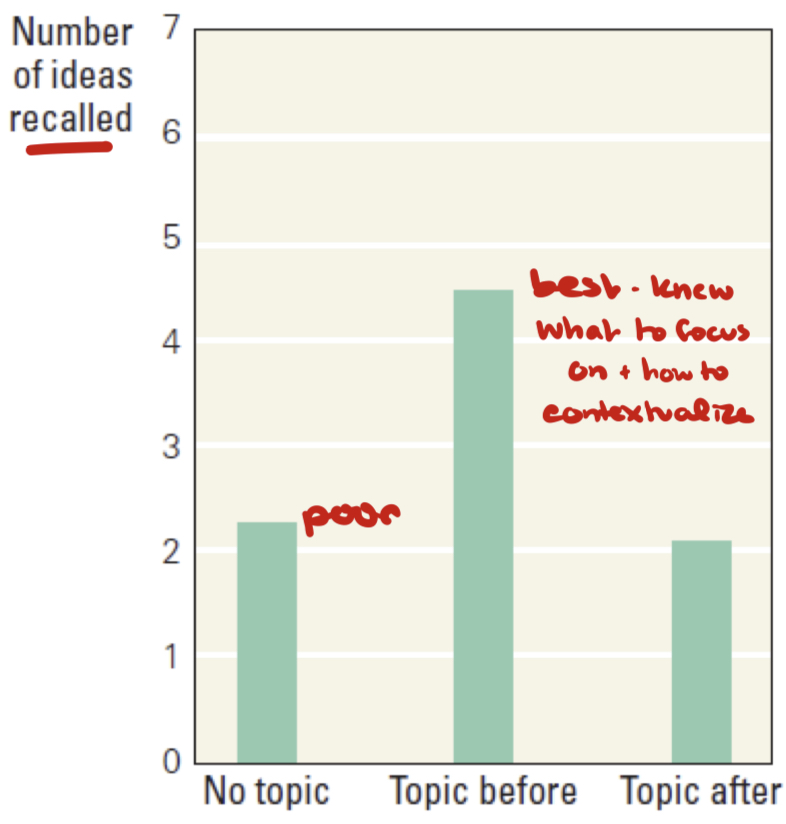
Encoding: Levels of Processing Framework
The more deeply you process information → the better it is encoded
Ex. memorize list of words with different depths of processing
Low-level: structural processing
Ex. capital letters, colour of words
Mid-level: phonemic processing
Ex. identifying rhymes
High-level: semantic or multisensory information
Ex. word meaning, imagery, making connections to own life
Consolidation
Process of making a memory more stable for storage
Makes it resistant to disruption
Solidified into storage form
Consolidation: Recency
Recent memories are more vulnerable to disruption
Trained rats with two different sounds in two different contexts with foot shock to elicit freezing, then repeated both sounds in a new context
Results:
Rats were much less afraid of more recent tone, short-term memory disrupted
Hippocampal damage → drop in freezing % of recent sound
Consolidation: Sleep
Sleep plays a key role in memory consolidation
Replaying new memories (REM/nREM)
Integrating new memories with existing semantic knowledge (nREM)
Connections and adding to frameworks
Procedural memory (REM)
Forgetting/pruning irrelevant information
Keep what’s meaningful
Reconsolidation
Each time we recall a memory, it becomes temporarily labile (susceptible to modification)
Memories can be updated with new information (true/false), associated with other memories, or weakened
Potential outcomes:
May get distorted
Could be externally influenced
But can have therapeutic benefits
Retrieval
Re-activating the memory for further processing
Accessing memories that have been encoded and consolidated into long-term storage
Making information accessible for conscious processing again
Different ways to test retrieval:
Recognition → yes/no
Recall → details
Cued recall
With a cue → activates trace
Free recall
As much information freely recalled without cues
Serial recall
Recall a list in order that it was encoded
Retrieval: Role of Cues
The more cues provided, the easier it is to recall a memory
Ex. what form of memory is for facts and general knowledge?
Free recall: ________
Cued recall: s______
Recognition: a) semantic, b) implicit, c) episodic
Retrieval: Testing to enhance memory
Testing Effect, Retrieval Practice, Test-Enhanced Learning
Roediger & Karpicke (2006)
Encoding
Students studied two short paragraphs
Later, re-read one paragraph (Reading condition), and wrote all they could remember about the other one (Testing condition)
Retrieval
Reading: 40% recalled
Testing: 55% recalled
Cerebral Cortex & Semantic Memory: Storage
Semantic memories seem to be stored in a distributed fashion throughout the cerebral cortex
Sensory cortices:
First cortical processing center for a sense
Somatosensory cortex, auditory cortex, visual cortex
Association cortices:
Links across senses
Get activated between sensory cortices and show links
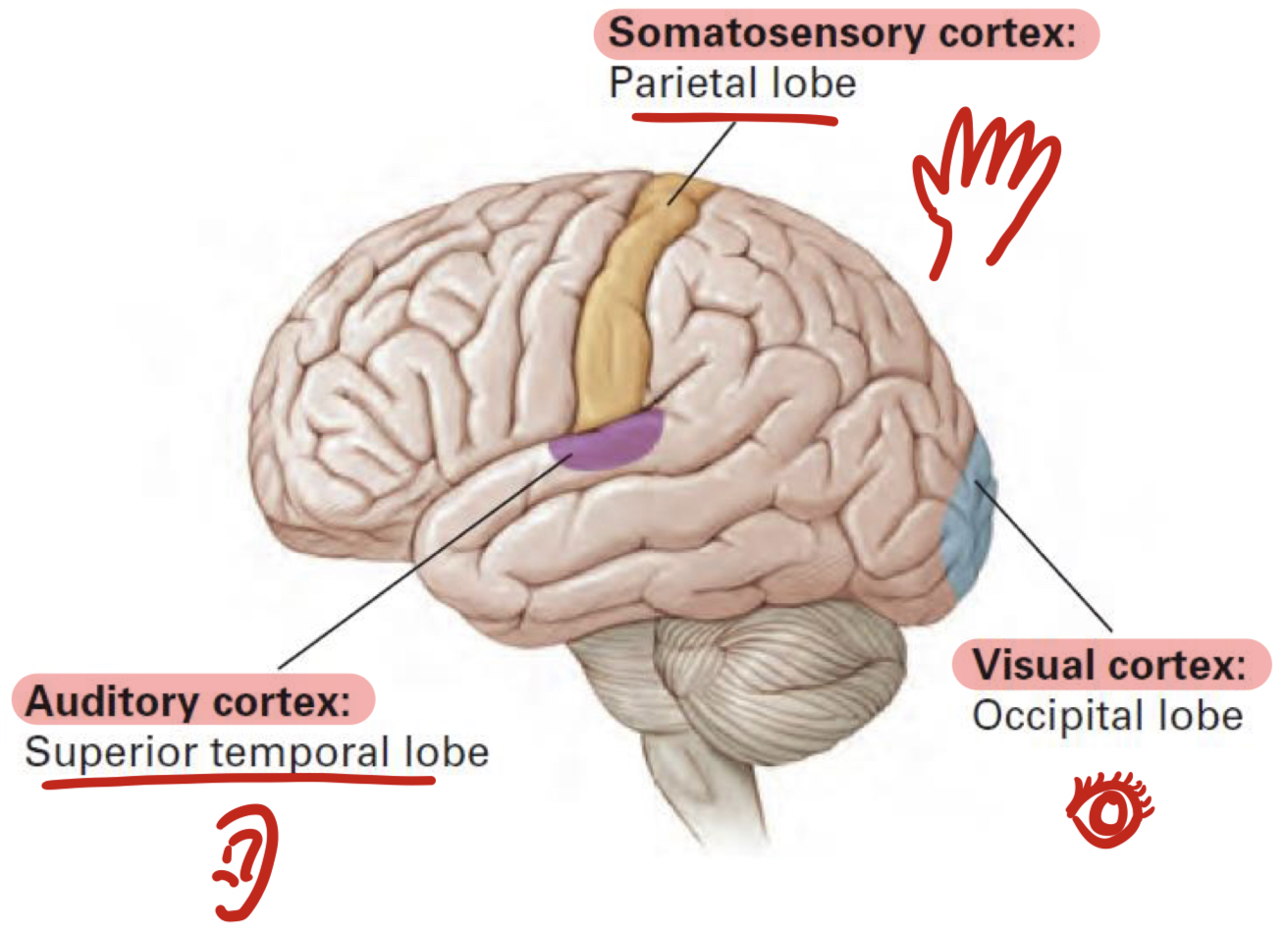
“Jennifer Anison“ neurons/”grandmother cells”
Recordings from the human cortex show that some neurons are tuned to specific semantic categories
One example:
A neuron in the right hippocampus of an awake human fires to pictures of Steve Carell but not photos of other celebrities
Some only fire to Jen Aniston
Some fire and are specific to anything about your grandmother
Frontal Cortex: Storage & Retrieval
May play an organizing role in declarative memories
Selecting information to be encoded into LTM
Suppressing hippocampal activity to inhibit memories
Frontal lobe damage causes problems of source memory (ex. not remembering if something was a dream or real), suggesting problems of retrieving complex memories
Accuracy depends on frontal lobe
Medial Temporal Lobes and Memory
Consolidation seems to depend on MTL
Hippocampus and surrounding cortices
Hippocampus
Lots of evidence to support role of hippocampus in memory consolidation (STM → LTM)
Activity during encoding of words is greater for words that are later remembered compared with those forgotten
↑ hippocampal activity → ↑ memory of words
Lesion in hippocampus:
Rodents cannot do episodic radial arm maze → search same arms over and over again
Scrub jays don’t remember where they cached food
Human patients (HM, Clive Wearing) cannot consolidate new experiences into LTM
HM: removed both hippocampi to treat epilepsy → lost consolidation ability, couldn’t form new memories, had some retrograde amnesia
Clive Wearing: memory reset every 30 secs
Hippocampus & MTL complex
So there is strong evidence that the MTL (especially hippocampus) consolidates declarative memories
2 current theories:
Standard Consolidation Theory
Multiple Trace Theory/Multiple Trace Memory Model
Standard Consolidation Theory
During learning, the MTL relays information to the cortex
MTL → cortex
During consolidation
Over time, however, the cortex gets the message and the memories become independent of the MTL
Cortex ←→ Cortex (builds webs)
After consolidation
Explanations
Explains why brain disruption usually damages recent memories (still undergoing consolidation) but not older memories (fully consolidated)
Multiple Trace Theory
The MTL helps organize together the distributed semantic facts into specific episodic memories
True episodic memories still rely on the hippocampus and MTL cortex for retrieval
Explanations
Explains cases of severe retrograde amnesia
Also suggests that spared memories after MTL damage are actually semantic rather than true episodic
LTP in the Hippocampus
What is happening at the level of the synapse when we form new episodic memories?
Remember LTP
Lots of Hebbian plasticity in hippocampus
Firing in neuron A causes joint activity in A and B - causes LTP in the connection between these neurons
Connection strengthens
